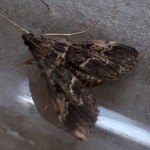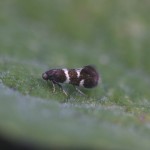And don’t forget to check out: http://www.mothnight.info/home
]]>
Matthew & Neil have made me aware that John Chainey took prunifoliella at Westleton last summer so I guess the moral of this story is – don’t assume all your Lyonetia are clerkella’s !!
]]>[Pictured below: Pale Pinion, Early Grey, Clouded Drab & Brindled Beauty]
]]>]]>
I’ve already posted about the Antispila sp’ found on 24 June but think I failed to mention that I also recorded my first garden clearwing sp’ that day when two Red-belted were enticed over from a neighbours apple tree. Sadly, attempts to lure in Yellow-legged and Currant Clearwing went unrewarded so I’ll just have to try again next year. A Platytes alpinella on 1 July was new, with Leopard Moth being another scare visitor. Another presumed breckland wanderer, Sitochroa verticalis, was new on 3 July amongst sixty species recorded. Other highlights that same night were Phoenix, Oak Nycteoline and my one and only Orange Moth of the year. A Prays ruficeps was new the following night, with a second individual noted on the 18th. The first few days of July also saw some quite high numbers (for me) of Common Footman. A Cream-bordered Green-Pea and Marbled Beauty were best of the bunch on 5th, as were Blackneck and Hedya salicella on 7th. It was then routine stuff until 14 July when Leopard and Coronet were noted. The 16th delivered a superb Marbled Clover. As well as the second ruficeps, the 18th scored with Anarsia innoxiella (the ‘not’ Peach Twig-borer!), my second Fen Wainscot (the first was in 2006, and the third followed a few days later on 20th) and, with thanks to Neil, Epinotia signatana, which was new. In his post Raymond mentions ohridella being abundant just before the weather broke. While used to seeing them on the car in the morning – I park next to a large horse chestnut – they seldom seem to wander the 20 metres or so into the back garden so counts of 40 (20th), 75 (24th) and 30 (26th) were of note. A Phyllonorycter ulmifoliella was picked out amongst the ohridella on 20th and expertly identified by Neil. A Small Ranunculus on 21st was a third for the garden, with Small Phoenix on 23rd only my second garden second. A Dusky Thorn on 18th and Canary-shouldered Thorn on 24th were hints that the season is marching on and autumn isn’t too far away. Metalampra italica has now been seen annually since 2014 and one was found indoors late month.
With seemingly regular reports from everywhere else I was hoping I’d pick up my own Oak Processionary but that wasn’t the case. Of other potential additions to the garden list I’ve also been looking out for perspectalis (the Box-tree Moth) but, perhaps, should have been thinking of something a bit more jazzy … so it was somewhat of a surprise to see a superb Jersey Tiger sitting on the top most egg-tray in the trap on Friday morning. This species is still rare in Suffolk with just a few coastal records so, subject to confirmation, mine could be a first for VC26 West Suffolk. What a great way to start a new month!
In other travels, I finally managed to add Sallow Clearwing to my life list when Matthew and I visited Chobham Common on 7 July (after following up a Twitter lead) and, later in the month, I popped down to RSPB Rye Meads to re-acquaint myself with Raspberry Clearwing. A species I’d not seen since July 2009 at the same site.
]]>
]]>
Sunday just gone (27 May) was a relatively quiet night in the garden trap (haven’t they all been!) but at least I beat the Blackbirds this time and, in the half-light, potted up a moth that was just about to take its leave. Looking at it through a hand-lens later on I was surprised to see what appeared to be a patch of orange scales under the eye. A check of the books and exchange of text messages with Neil confirmed my suspicion that I had the latest addition to the garden list … Coleophora amethystinella.
]]>










